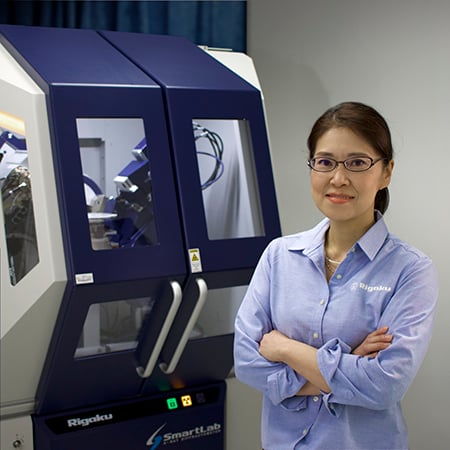High Quality XRD Measurements Using Capillaries

This is a written summary of a live webinar presented on November 26, 2024. The recording and resources are available on the recording page.
Presented by:
.jpg?width=875&height=990&name=Mardegan_picture_Fev2020%20(2).jpg)
Webinar summary
The webinar focused on the advantages, challenges, and optimized practices for conducting transmission X-ray diffraction (XRD) using capillaries. Jose explained that capillary-based XRD is especially beneficial for air-sensitive, toxic, or limited-quantity samples due to the sealed nature and low volume requirements of capillaries. Capillaries facilitate remeasurement, reduce contamination risks, and allow for long-term storage with minimal degradation. They also reduce preferred orientation effects when spun during data collection, enhancing statistical representation in diffraction patterns.
The session contrasted transmission mode XRD with traditional Bragg-Brentano reflection mode, clarifying that the latter uses a divergent beam suitable for flat, homogeneous samples, whereas transmission mode relies on parallel or convergent beams that pass through the sample, requiring different optics and alignment strategies. Jose emphasized the use of Rigaku’s specialized optics like the CBO and CBO-E, which convert divergent beams into parallel or convergent ones for optimal transmission measurements, and showcased sample holders such as pre-aligned capillary mounts and goniometer-based heads for manual or automated sample alignment and spinning. Detailed guidance was provided on selecting capillary materials—borosilicate for routine use and quartz for high-temperature applications—as well as choosing capillary diameters to balance absorption and sample quantity.
Data optimization was a core theme, with recommendations to tailor the incident beam slit size to the capillary diameter, ideally aiming for 5–10 data points across the full width at half maximum (FWHM) of diffraction peaks. For quantitative analysis, a high count rate and minimized noise are critical. The presentation further addressed the practical challenges of highly absorbing materials like iron-rich powders when using copper radiation. Three main strategies were outlined: using higher energy X-ray sources (Mo or Ag), employing thinner capillaries, or diluting the sample with amorphous silica to increase transparency while preserving structural detail. Dilution strategies were demonstrated through comparative scans, showing how the peak-to-background ratio can be improved by careful sample preparation, and a rule-of-thumb of 60% sample to 40% silica was offered for general guidance.
The webinar also explored detector technologies, tracing the evolution from 0D scintillation detectors to modern 1D strip and 2D pixel detectors. Rigaku’s 2D detectors like HyPix and XSPA were highlighted for their superior energy resolution and ability to detect subtle texture or orientation effects in capillary-mounted samples. Jose explained that 2D detectors are particularly advantageous for dynamic studies, phase transitions, and temperature-dependent experiments due to their ability to capture complete diffraction rings. Sample preparation was stressed as a decisive factor in data quality, including thorough homogenization with mortar and pestle and innovative approaches like using a vibrating toothbrush to aid powder loading into fine capillaries.
Finally, Jose reiterated that high-resolution, high-signal data suitable for quantitative analysis are achievable with capillary setups, provided that sample homogeneity, optics, detector mode, and measurement parameters are carefully considered.
Key questions answered in the webinar:
-
X-ray diffraction (XRD) is a powerful, non-destructive analytical technique used to study the internal structure of materials. It works by directing X-rays at a sample, which then scatter in a pattern unique to the material's atomic arrangement. By analyzing this scattering pattern, XRD can reveal several key properties:
- Phase identification: It can distinguish between different crystalline phases present in a sample (e.g., identifying rutile versus anatase, even though both are titanium oxide, based on their distinct structures).
- Structural information: It determines the crystal structure (e.g., cubic, tetragonal, hexagonal) and lattice parameters of the material.
- Quantitative analysis: It can quantify the amount of each phase present in a multi-phase sample (e.g., determining the percentage of anatase and rutile in a mixture).
- Crystallinity and grain size: It provides insights into the crystallinity of a sample (how ordered it is), the amount of amorphous content, and the average crystallite or grain size.
-
While both XRF and XRD utilize X-rays, they extract different types of information and are complementary techniques:
- XRF (X-ray fluorescence) is primarily sensitive to the elemental composition of a sample. It tells you what elements are present in your material and in what quantities. For example, in a titanium oxide sample, XRF would only identify titanium and oxygen.
- XRD (X-ray diffraction) is sensitive to the structural arrangement of atoms. It tells you how the elements are bonded and organized within the material, forming specific crystal structures. For the titanium oxide example, XRD would distinguish between rutile and anatase based on their different diffraction patterns, even though they contain the same elements.
Combining both techniques can provide a comprehensive understanding of a material's elemental makeup and its internal structure, leading to more complete characterization.
-
Using capillaries for XRD measurements, particularly with powder samples, offers several significant advantages:
- Handling sensitive samples: Capillaries are ideal for toxic, air-sensitive (e.g., sensitive to humidity or prone to rapid oxidation), or liquid samples, as they can be sealed (e.g., with wax) to maintain a controlled environment.
- Easy manipulation and storage: Samples enclosed in capillaries are easy to handle and manipulate without direct contact, reducing contamination risks for both the sample and the user. They are also relatively cheap, allowing for easy preparation, labeling, and long-term storage for re-measurement.
- Small sample volumes: Capillaries require only a tiny amount of sample, often in the microgram range, making them suitable for precious or limited materials while still yielding good signal quality (though potentially requiring longer measurement times).
- Reduced background signal: When measuring light elements or organic materials, capillaries often provide a cleaner signal with less background interference compared to traditional flat sample holders, which can introduce peaks from their material (like aluminum).
- Minimizing preferred orientation: Capillaries can be spun or oscillated during measurement, which helps to average out any preferential alignment of grains in the powder. This minimizes "preferred orientation" effects, resulting in a more representative and accurate diffraction pattern.
-
Capillaries for XRD measurements are commonly made from:
- Borosilicate glass: This is the most frequently used material in daily laboratory settings. It is transparent to X-rays and relatively inexpensive. While a bit fragile, it's not easily broken. Borosilicate is a good choice for general-purpose measurements where high temperatures are not involved.
- Quartz: Quartz capillaries are a purer material and are also X-ray transparent. They are more robust and less fragile than borosilicate. Their main advantage is their ability to withstand high temperatures (over 1000°C), making them suitable for in-situ high-temperature XRD experiments. However, they are more expensive than borosilicate glass.
- Kapton/Beryllium: These materials are primarily used in synchrotron facilities due to their specific properties, such as very low absorption, which allows for higher quality data in specialized experiments.
The choice of material depends on the specific experimental needs, particularly regarding temperature requirements and desired data resolution.
-
XRD measurements can be performed in two main geometries:
- Reflection mode (Bragg-Brentano geometry): In this setup, the X-ray source and detector move in a coupled fashion, with the sample typically held flat on a sample holder. The X-rays hit the surface of the sample, and the diffracted X-rays are measured from the same side. This mode requires a flat and homogeneous sample surface to obtain high-quality, high-resolution data. It's the most common setup for bulk powder samples.
- Transmission mode: In transmission mode, the X-ray source is typically fixed, and the detector scans around the sample. The X-rays pass through the sample (e.g., contained within a capillary or as a thin foil), and the diffracted X-rays are measured on the opposite side. Transmission mode does not require a flat sample surface and is particularly suitable for:
- Capillary measurements: As X-rays pass through the entire sample within the capillary.
- Small or irregularly shaped samples: Where preparing a flat surface is difficult.
- Samples susceptible to preferred orientation: As spinning the capillary in transmission helps mitigate this effect.
- In-situ experiments: Where samples are contained in environmental cells or flow-through setups.
For transmission measurements, it is crucial to use a parallel or convergent X-ray beam, unlike reflection mode which typically uses a divergent beam.
-
Measuring highly absorbing materials (e.g., those containing heavy elements like iron or cobalt) with XRD capillaries, especially using a standard copper X-ray source, presents challenges due to significant X-ray absorption, leading to very low signal or no discernible peaks. Solutions to overcome this include:
- Using higher-energy radiation (e.g., molybdenum or silver source): Higher energy X-rays penetrate denser materials more effectively, reducing absorption and resulting in stronger and clearer diffraction signals. This, however, requires investing in a different X-ray source.
- Using thinner capillaries: Opting for capillaries with smaller diameters (e.g., 0.1 mm or 0.2 mm instead of 0.4 mm) reduces the amount of material the X-rays have to pass through, thereby lowering absorption. This can improve signal but might still not be sufficient for very dense samples.
- Diluting the sample: Mixing the highly absorbing sample with a lightweight, amorphous diluent (like amorphous silica) significantly reduces the overall absorption. The diluent should ideally be X-ray transparent and not produce its own diffraction peaks (though an amorphous "bump" might appear, which can often be computationally removed). A common recommendation is to aim for around 60% sample concentration when diluting with amorphous silica, though the ideal ratio depends on the sample's density and absorption coefficient. This method is effective and can be implemented without changing the X-ray source or capillary size, making it a cost-effective solution.
-
Good sample preparation is crucial for obtaining high-quality XRD data from capillaries:
- Fine powder consistency: The sample must be a fine powder, ideally below 50 micrometers. This ensures even packing within the capillary and avoids voids. Grinding the sample using a mortar and pestle or a mill is recommended to achieve this.
- Homogenization: For multi-phase samples or diluted samples, thorough mixing and homogenization (e.g., by grinding in a mortar for at least 30 minutes) are essential to ensure the measured portion is representative of the entire sample.
- Efficient capillary filling: Filling capillaries with fine powders can be challenging. A practical tip is to use a vibrating device, such as an old electric toothbrush, to gently vibrate the capillary. This helps the powder settle evenly and quickly inside, preventing air pockets and achieving uniform packing. Avoid buying specialized, expensive vibrators as a simple toothbrush works effectively.
-
The evolution of X-ray detectors has significantly enhanced XRD measurements, particularly in transmission mode:
- 0D (Zero-dimensional) detectors (e.g., scintillator detectors): These were traditionally used and count X-ray photons without providing positional information on the detector surface. They require a narrow receiving slit to ensure good angular resolution, limiting intensity.
- 1D (One-dimensional) detectors: These detectors feature sensitive stripes or linear arrays of independent detector elements. They offer improved resolution and significantly higher intensity compared to 0D detectors because they don't require a slit before the detector. This allows for faster measurements or lower X-ray dose to the sample.
- 2D (Two-dimensional) detectors: These are the most advanced detectors, consisting of a grid of pixels, providing information not only in the 2θ (angular) direction but also in the β (azimuthal) direction. This allows for:
- Visualization of diffraction rings: Directly observing diffraction rings, which can reveal information about grain size effects or preferred orientation.
- Real-time monitoring: Easily seeing phase transitions or other changes in the sample during in-situ experiments (e.g., heating), and even creating "movies" of these changes.
- High resolution and sensitivity: Modern 2D detectors offer excellent energy and spatial resolution, although excessively small pixel sizes might not yield significant practical benefits for typical powder diffraction over reasonably sized ones (e.g., 75-100 micrometers).

Subscribe to the Bridge newsletter
Stay up to date with materials analysis news and upcoming conferences, webinars and podcasts, as well as learning new analytical techniques and applications.

Contact Us
Whether you're interested in getting a quote, want a demo, need technical support, or simply have a question, we're here to help.
